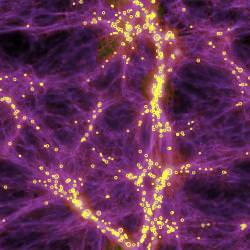A supercomputer simulation has retraced the evolution of the Universe, giving astronomers new clues on where they should point their telescopes. And it seems that one of the most important ingredients to this cosmic recipe is black holes.
The simulation is called BHCosmo, and it was performed on the Cray XT3 system at the Pittsburgh Supercomputing Center. The researchers tied up the whole system – 2,000 processors – for 4 weeks to run the simulation.
They started with initial conditions that matched the cosmic microwave background radiation. Next they seeded the area with 250 million particles of matter, and surrounded that with the gravitational force of dark matter. The researchers watched how the particles of matter collapsed to form galaxies and black holes.
One of the most important findings of the simulation was the impact of black holes. Galaxies look the way they do because of the supermassive black holes at their centres.
Eventually they hope to model the entire Universe with a resolution that matches the Sloan Digital Sky Survey, but that will take more computer power.
Original Source: Carnegie Mellon

